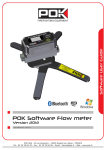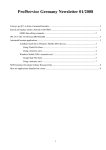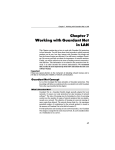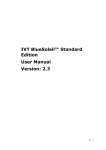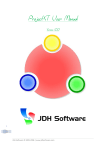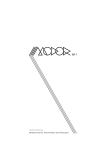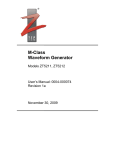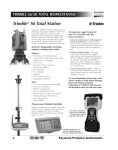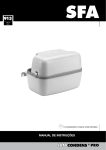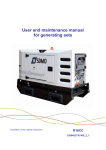Download BTHMGR-CE60-02J-US User Manual
Transcript
ADENEO
BLUETOOTH MANAGER
USER'S MANUAL
Réf. : BTHMGR-CE60-02I
06/2008
BTHMGR-CE60-02I-US
Page 1/21
ADENEO
User's Manual
HISTORY
Revision
Date
Author
A
30/06/05
MLA
Creation
B
13/03/06
ACHAN
Update
C
09/06/06
RMO
Update
D
28/03/07
VGU
Update for version 1.7 , add the modules requirements
E
25/04/07
VGU
Update for version 2.0 , WM5 pictures changed
F
25/06/07
VGU
Add modules requirements for HSP and HFP profiles
G
05/04/08
RMOES
Add PAN profile
H
12/06/08
JBPIGN
Add A2DP profile
I
30/06/08
JBPIGN
Add ActiveSync compliance in SPP
J
10/07/08
ORABO
Add OPP speed choice
06/2008
Description
BTHMGR-CE60-02I
Page 2/21
ADENEO
User's Manual
TABLE OF CONTENTS
1. General Features
4
1.1 Document Presentation .....................................................................................................4
1.2 Documentation...................................................................................................................4
1.2.1 Applicable Documentation ...........................................................................................4
1.2.2 Standards ....................................................................................................................4
1.2.3 Associates documents.................................................................................................4
1.3 Acronyms...........................................................................................................................4
2. Modules requirements
4
2.1 Catalog items .....................................................................................................................4
2.2 Others ................................................................................................................................5
3. Installation
5
4. BlueTooth Manager
5
4.1 Main window description....................................................................................................5
4.1.1 The main window.........................................................................................................5
4.1.2 The toolbar ..................................................................................................................6
4.1.3 The status bar..............................................................................................................6
4.2 Inquiry devices ...................................................................................................................6
4.3 Device pairing ....................................................................................................................7
4.4 Properties and configuration ..............................................................................................8
4.4.1 Local services..............................................................................................................8
4.4.2 Local device properties and configuration ...................................................................11
4.4.3 Distant device properties .............................................................................................12
4.5 Distant services..................................................................................................................12
4.5.1 Services Inquiry ...........................................................................................................12
4.5.2 File Transfer ................................................................................................................13
4.5.3 Object Push .................................................................................................................13
4.5.4 Serial Port....................................................................................................................14
4.5.5 Dial-Up Networking......................................................................................................16
4.5.6 Personal Area Networking (PAN Profile) .....................................................................16
4.5.7 A2DP ...........................................................................................................................17
4.6 Distant disconnection management ...................................................................................18
4.7 Connection shortcuts management ...................................................................................18
4.8 Stop the Bluetooth Manager ..............................................................................................20
4.9 Registry information ...........................................................................................................20
06/2008
BTHMGR-CE60-02I
Page 3/21
ADENEO
User's Manual
1. General Features
1.1 Document Presentation
This document describes how to use the Bluetooth Manager for Windows CE. This document is for users
and developers who need to use Bluetooth functions:
This document describes:
•
Software Installation.
•
Bluetooth Manager usage (with screenshots)
1.2 Documentation
1.2.1 Applicable Documentation
1.2.2 Standards
1.2.3 Associates documents
1.3 Acronyms
WM5 : Windows Mobile 5.0
FTP : File Transfer Profile. Bluetooth service used to browse, download and upload files.
OPP : Object Push Profile. Bluetooth service used to upload files and contact cards.
SPP : Serial Port Profile. Bluetooth service used to open a virtual serial communication between two
devices.
A2DP: Advanced Audio Distribution Profile profil used to have Hi-Fi sound.
2. Modules requirements
2.1 Catalog items
To use the bluetooth manager on a target device, the target device must have the following modules:
•
CAB File Installer/Uninstaller (to use binary package)
•
USB Host Support (or Serial Port Support)
•
Bluetooth Stack with Integrated CSR Chipset Driver
•
Graphical Shell (Standard Shell , AYGShell API Set if no Mouse device)
•
Bluetooth Stack with Integrated USB Driver (or UART-Only Driver)
•
Microsoft Foundation Classes
•
Object Exchange Protocol (OBEX) /Obex Server + Obex Client
•
C Libraries and Runtimes
o
C++ Runtime Support for Exception Handling and Runtime Type Information
•
Component Object Model (COM/DCOM)
•
MSXML 3.0/ XML Core Services and Document Object Model (DOM)
•
Bluetooth HS/HF and Audio Gateway Service
The following environment variable:
•
Sysgen_bth_a2dp = 1
The following modules are optional (add profiles)
•
06/2008
Bluetooth PAN
BTHMGR-CE60-02I
Page 4/21
ADENEO
User's Manual
2.2 Others
•
Add the registry : [HKLM\Software\Microsoft\Bluetooth\HandsfreeProfileOn]
•
Add the BTSCOSND audio driver for audio routing to Bluetooth hardware in Built-in WAV1:
SYSGEN_BTH_AUDIO
3. Installation
The installation program is a file with .CAB extension. This file must be copied on the Windows CE device
and then executed to be installed on the device.
By default, the bluetooth manager is installed in the “\Program Files\BthManager” directory. The
installation program also creates the following directories:
•
“\My Documents\Bluetooth\Ftp” : a directory where all downloaded file by the FTP profile will be
put
•
“\My Documents\Bluetooth\Opp”
4. BlueTooth Manager
4.1 Main window description
4.1.1 The main window
When the bluetooth manager is run, a new window appears and a bluetooth icon appears in the task bar.
This window contains a toolbar with some icons, a status bar, and a list window:
List Window
Tool bar
Menu Bar
Status Bar
Windows Ce
version
Windows mobile
version
NB: Windows Mobile Version provide a Menu Bar with 2 soft keys “Refresh” and “Menu”. The Menu
button provides a menu with all the actions available in the Toolbar.
06/2008
BTHMGR-CE60-02I
Page 5/21
ADENEO
User's Manual
4.1.2 The toolbar
Stop the current action
Refresh
Parent Folder (FTP)
Show the about box
Show favorite list
Configure the application
Show distant devices
Show local services
Not available on Windows mobile version, a Menu bar is used instead of it.
4.1.3 The status bar
State
Working indicator
Distant device
State: What the bluetooth manager is doing and the name of the current view
Working indicator: For long task (Inquiry, Connection)
Distant device: With which device the bluetooth manager is currently connected
4.2 Inquiry devices
When the application is started, you need to click on
(“Menu>Devices” for WM5) to start inquiry
remote Bluetooth devices. The devices found are shown in the main window. They are represented by an
icon (showing what class of device they are: computer, laptop, pda, audio device) and the name of the
device.
06/2008
BTHMGR-CE60-02I
Page 6/21
ADENEO
User's Manual
Once you have clicked one time on
all futures clicks will show devices without inquirying (to
decrease search time). To inquiry again remote bluetooth devices you must refresh the list by clicking on
(“Menu>Refresh” for WM5). (Note : All the coupled devices are shown without inquiry)
In the list, after an inquiry, some device class and name can be not found. You can update this by right
clicking on the device and select update in the contextual menu:
During an inquiry, you can stop it by clicking on the
icon (“Menu>Stop” for WM5).
4.3 Device pairing
The device pairing can be done in three ways :
•
We want to be paired with another distant device
For that the distant device must be in the list window to be paired with the current device. Right click
on the selected device and click on pair
A new window appears to insert the pin code. The pairing can be canceled by clicking on the close
button or started by clicking on the OK button (after typing a pin code).
•
A distant device try to pair with the current device (with no Auto Pin Code)
When a device try to pair with the current device, a new window appear to enter the pin code selected by
the distant device.
•
A distant device try to pair with the current device (With auto Pin Code)
In this case, the user is not invited to type a pin code. It is automatically typed for him.
NB: On WM2005 the pin request from remote device are not managed by the application. The
Bluetooth stack manage it. So remote device icon which requesting pairing will not seems paired.
06/2008
BTHMGR-CE60-02I
Page 7/21
ADENEO
User's Manual
After the pin code is typed (or auto typed), there is two issues :
Device is not paired
Device is paired
4.4 Properties and configuration
4.4.1 Local services
4.4.1.1 General
In the Bluetooth Manager v1.5, there are three local services proposed to distant devices:
SPP (Serial Port): A distant device wants to establish a serial connection with the local device
OPP (Object Push): To receive files and contact information card
PAN (Personal Area Networking): To create a Network with the device.
FTP (File Transfer): To access to local directories, files and upload files and create directories
Note : the OPP and FTP profil cannot be separated : You cannot deactivate one without deactivate the
second.
Click on
(“Menu>Local services” for WM5), to administrate local services. Local services are
shown in the list view with a specific icon and an explicit name.
You can activate or deactivate a local service by double-clicking it or by right clicking it and selecting
the Start or stop item from the contextual menu.
The local service is not activated
The local service is activated
You can also configure the service by selecting the Properties Item when you right click him.
4.4.1.2 SPP Profile
Load the SPP Server :
If the Auto Server COM Port is not checked (cf. 4.4.2.3. Application properties)
06/2008
•
The application shows a dialog box with all the available port COM
•
Select the COM Port to be mapped with the SPP Server
•
The Serial Port profile is activated
BTHMGR-CE60-02I
Page 8/21
ADENEO
User's Manual
If the Auto Server COM Port is checked, the serial Port profile is activated with the last used COM Port
for the SPP Server profile. If it is not available, an error appears.
If the service is connected you can know the COM port assigned by selecting “Properties” in the
contextual menu of the service.
4.4.1.3 FTP Profile
You can change the directory of the FTP server (directory seen by distant device) in the service
properties (Contextual menu) ( Not supported on Windows mobile version)
4.4.1.4 OPP Profile
You can change the directory where the File sent by distant device will be put. ( Not supported on
Windows mobile version)
06/2008
BTHMGR-CE60-02I
Page 9/21
ADENEO
User's Manual
4.4.1.5 PAN Profile
Load the PAN Server: you must choose the type used by the local profile (between PANU/GN/NAP)
But take care that the Bluetooth PAN configuration cannot be modified without:
•
WinCE6: restarting the service, so any connection to this service will be deleted:
•
WinCE5: restarting the Bluetooth stack: so any connection active on the device will be stopped.
For this a dialog message appears to inform the user:
You can change the TCP/IP settings of the BTPAN miniport.
You can change the authentication and encryption settings and also get the current type used by the
PAN profile (between PANU/NAP/GN)
06/2008
BTHMGR-CE60-02I
Page 10/21
ADENEO
User's Manual
4.4.2 Local device properties and configuration
Click on
, to see:
•
the local device properties (MAC address, name and device type)
•
application option (start minimized, Auto assigned COM port number for client SPP and
server).
•
security options of the bluetooth manager
4.4.2.1 Security properties
Distant devices must be
paired to access local
services
Don’t show a window
when a distant device
wants to be paired. Autotype the PIN code number
The current device is
visible or not from other
devices.
4.4.2.2 General properties
Name for distant device of
the current device
MAC Address
current device
of
the
Class of device of the
current device
4.4.2.3 Application properties
Check this if you want the
bluetooth manager starts
minimized
Check this if you want to
affect the first available
COM port to a SPP client
connecion
Check this if you don’t
want a dialog appears
when you start the SPP
server (to select the COM
port)
Check this if you want to
enable the write access
on the FTP server (NOT
FOR WM5)
06/2008
BTHMGR-CE60-02I
Page 11/21
ADENEO
User's Manual
4.4.2.4 About Box
Click on the
icon if you want some general information about the bluetooth manager:
•
Version
•
License information
4.4.3 Distant device properties
You can have general information on a distant device (like the General tab of the Local device
properties) by selecting “properties” in the contextual menu of the distant device.
4.5 Distant services
4.5.1
Services Inquiry
To inquiry the services available on a distant device, you have to double click on this one. After that, the
bluetooth manager inquiries (it indicates this in the status bar) for all the services (among
SPP/FTP/OPP/DUN) of the distant device. You can stop the inquiry with the
WM5). You can also refresh the list of services by clicking on the
06/2008
BTHMGR-CE60-02I
icon (“Menu>Stop” for
icon (“Menu>Refresh” for WM5).
Page 12/21
ADENEO
User's Manual
4.5.2 File Transfer
To use this service, double click on the
icon or choose connect on the contextual menu (right
click). Then, the bluetooth Manager tries to connect to the distant service. If the connection is successful,
the root directory shared by the distant will be shown in the list view. You can browse the device by
double clicking on the remote folder and go to the parent directory with
WM5).
(“Menu>Parent folder” for
To get a file, double-click or choose “Get File” from the contextual menu. A window is displayed to
indicate the transfer state.
The file is downloaded by default to the “\My Documents\Bluetooth\Ftp” directory. You can change this
one with the FTP properties (contextual menu of the File Transfer service).
You can upload a file to the distant device by right-clicking on a whitespace of the listview and select Add
file.
You can also delete a file by selecting delete on his contextual menu.
4.5.3 Object Push
To use this service, double-click on the distant service or select “Push file” on the contextual menu. Then
you can choose the file to transfer.
06/2008
BTHMGR-CE60-02I
Page 13/21
ADENEO
User's Manual
You can choose the speed of transfer (High speed or Low speed) when you select “Properties” on the
contextual menu. Low speed is a buffer of 64KBytes and High speed is a buffer of 5000Kbytes.
Then you can check the box or not. If the box is checked, High speed transfer is selected whereas if
the box is not checked, Low speed transfer is selected.
4.5.4 Serial Port
To use this serial service, double-click on the icon or choose “Connect” from the contextual menu.
If the Auto Client COM Port is not checked (cf. 4.4.2.3. Application properties)
•
The application shows a dialog box with all the available COM
If the Auto Client COM Port is checked (cf. 4.4.2.3. Application properties)
•
The Application selects automatically the first avalaible COM port in the system.
If the connection is successful a messagebox appears:
06/2008
BTHMGR-CE60-02I
Page 14/21
ADENEO
User's Manual
else an error message appears
The status of the service (connected or not) is displayed as shown below:
Service not connected
Service connected
When the service is on, all applications could use the virtual COM port. To know the COM port setting,
select properties in the contextual menu.
If you want to connect to a device that has ActiveSync installed, proceed as follow:
•
Make sure that the remote device has the right COM port selected in the ActiveSync
configuration.
•
Long click on the SPP icon then select “Bind to ActiveSync”:
•
A connection should be launched and Activsync is connected.
•
When you want to Disconnect to ActivSync, proceed on the same way and select “Unbind to
ActiveSync”
When connected, the Manager can still be used as usual.
06/2008
BTHMGR-CE60-02I
Page 15/21
ADENEO
User's Manual
4.5.5 Dial-Up Networking
To use the Dial-up Networking service, double click on the icon or choose "Connect" in the contextual
menu. The first avalaible COM port in the system is assigned to the DUN profil on the selected device.
The status of the service (connected or not) is displayed as shown below:
Service not connected
Service connected
When connected, the Manager can still be used as usual. A modem associated to the COM port used
by the service is created and can be used to establish a Dial-Up connection. To know the COM port
settings, select properties in the contextual menu.
The modem created by the Manager is displayed in the list of available modems for Dial-Up
connection when making a new connection ("Make New Connection" icon in the "Network and Dial-Up
Connection" system window).
4.5.6 Personal Area Networking (PAN Profile)
The name of the service can be “Personal Area Network User” for PANU PAN profile, “Group Ad-hoc
Network” for a GN PAN profile or “Network Access Point” for a NAP PAN profile.
To use the Dial-up Networking service, double click on the icon or choose "Connect" in the contextual
menu.
06/2008
BTHMGR-CE60-02I
Page 16/21
ADENEO
User's Manual
If the connection is successful a messagebox appears:
The status of the service (connected or not) is displayed as shown below:
Service not connected
Service connected
When connected, the Manager can still be used as usual.
You can configure the TCP/IP settings of the BTPAN by selecting properties in the contextual menu.
4.5.7 A2DP
The name of the service is “Audio Stereo”, to use it, make sure that the device is paired before double
click on the icon or choosing "Connect" in the contextual menu.
The status of the service (connected or not) is displayed as shown below:
Service not connected
Service connected
If the connection fails, an error message should appear:
06/2008
BTHMGR-CE60-02I
Page 17/21
ADENEO
User's Manual
You can configure the audio settings of the A2DP by selecting properties in the contextual menu.
4.6 Distant disconnection management
When a connection, previously established, is shut down by the distant host (manual disconnection or
connection loss due to distant device shutting down or due to a weak signal), the user is notified of the
disconnection and the Manager attempts to reconnect during a time t (by default, 1min30). The
notification is made by a pop-up window and by changing the icon associated to the disconnected
service.
4.7 Connection shortcuts management
Shortcuts associated to defined services on defined devices make establishing connections with
distant devices easier. A shortcut can be created by selecting the "Create Shortcut" item in the contextual
menu of a connected service. If the shortcut already exists, a notification is displayed. If the shortcut is
successfully created, a notification is also displayed.
06/2008
BTHMGR-CE60-02I
Page 18/21
ADENEO
User's Manual
The
button in the tool bar (“Menu>Shortcuts” for WM5) displays the connection shortcuts list. The
service, the device and, eventually, the COM port are used in the shortcut name.
To establish a connection from the shortcut, double-click on the icon or select "Connect" in the
contextual menu. Once the connection is established (even if the connection is not successfully
established), the display is switched to the services list associated to device linked to the shortcut. The
connection status of the service (connected or not) is displayed not only on the service icon but also on
the associated shortcut icon. However, disconnection can only be performed from the service contextual
menu.
Shortcuts can be deleted by using the "Delete" item of the contextual menu. The user must confirm the
deletion.
The content of the shortcut list is saved between executions of the Manager.
06/2008
BTHMGR-CE60-02I
Page 19/21
ADENEO
User's Manual
4.8 Stop the Bluetooth Manager
When the BlueTooth Manager window is closed (by the close button X), the application is still running in
the background.
•
Windows CE :
To display or stop it, click on the BlueTooth icon on the Windows bar and select: “Show” or “Exit” . You
can also display it by starting again the application
•
Windows mobile:
To display it, click on the BlueTooth ( left icon) icon on the Windows bar.
To stop it , go to Start Menu >Parameters>”System tab” and select the memory manager.
Go to the current running programs tab and select the “BthManager” then click on Stop.
4.9 Registry information
The Bluetooth Manager configuration is stocked in the registry:
[HKEY_LOCAL_MACHINE\SOFTWARE\ADENEO\BthManager]
•
AutoClientCOM
Set at 0 : Ask for a COM port when connecting to a distant SPP profile
•
AutoServerCOM
Set at 0 : Ask for a COM port when activating the SPP local service
•
StartMinimized
Set at 0 : The Bluetooth manager start maximized
•
LocalPortCom
Set at X : The SPP local service is connected with the COMX:
06/2008
BTHMGR-CE60-02I
Page 20/21
ADENEO
•
User's Manual
Reconnection Timeout
Set at X : The application stops trying to connect after a distant disconnection afer X seconds
•
Scan Period
Set at X : The application scans for disconnection every X seconds
•
Default Pin Activated
Set at 0 : The application asks to the user to write a PIN code when a device asks for pairing
•
LocalPinRequest
If the “Default Pin Activated” is set at 1, this is the PIN code return to the distant device.
•
LastView
Save the last view ( Shorcuts, Devices, Local services, etc…) from the last run of the application to
retrieve it when restarting
Shortcuts\* contains all the informations about shortcuts.
06/2008
BTHMGR-CE60-02I
Page 21/21






















